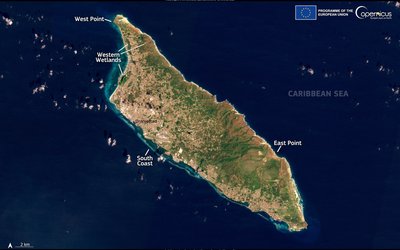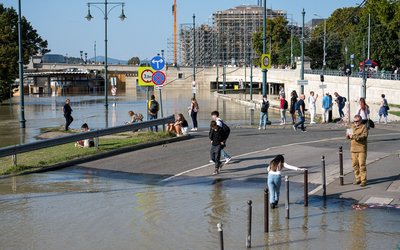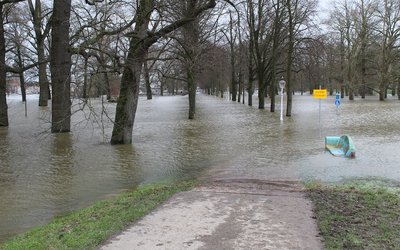
Heavy rainfall in the Alps has become a matter of concern in recent years because of the major disruptions to human systems caused by flash floods, regional floods and landslides. The intensity of heavy rainfall is increasing.
Textbook examples
Scientists analysed rainfall observations from 883 rain gauge stations across Austria over the period 1900 to 2023. They show that the amount of rainfall in one hour during heavy downpours has increased significantly over the last four decades. The amounts of heavy rainfall during a day have also increased. The increase of hourly heavy rainfall has resulted in an increase of floods in small catchments. The increase in daily heavy rainfall has led to an increase of flood peaks in medium-sized and large catchments. These changes are textbook examples of the impact of climate change on heavy rainfall and resulting flood peaks.
15% increase hourly heavy rainfall
Hourly heavy rainfall in Austria has increased by 15% over the last four decades, both north and south of the Alpine ridge. This is fully consistent with our current understanding of extreme rainfall evolution in a warming climate. Warmer air can hold more water vapour and downpours are therefore becoming more extreme. The intensity of heavy rainfall increases by 7% for every degree Celsius of global warming.
8% increase daily heavy rainfall
Hourly changes in heavy rainfall are closely linked to higher air temperatures. However, daily changes in heavy rainfall are largely due to other processes, particularly changes in atmospheric circulation. Rainstorms are moving more slowly now than they did forty years ago. This slowing of the movement of rainstorms is due to a decrease in the temperature difference between the mid-latitudes and the North Pole. When rainstorms slow down, it rains longer in a given area. In the summer of 2021 we saw where this can lead.
Daily heavy rainfall in Austria has increased by 8% over the last four decades, on average. However, the increase is much greater in the north than in the south of the Alpine ridge.
Floods in small catchments
Hourly rainfall extremes are generated by convective storms and are, therefore, local phenomena. These extremes tend to be most relevant for the creation of high discharges in small catchments. Smaller catchments respond more quickly to these extremes than larger ones.
The analysis clearly shows this correspondence between flood peak discharges in small Austrian catchments and hourly heavy rainfall. In fact, the increase in floods is greater than that of rainfall, about 25% over the last four decades. The increase of hourly heavy rainfall is ‘only’ 15%. The transition from rain to river discharge is a nonlinear process. In the case of the Austrian catchments, a given change in hourly heavy rainfall translates into an almost twice as large increase in floods. This illustrates that a relatively modest increase of water-holding capacity of the atmosphere can have large effects on floods. In Austria, at 2 °C regional warming, an increase of this capacity by 7% per degree Celsius leads to a 28% increase in flood discharge in small catchments.
Floods in large catchments
Long-lasting rains determine flood peaks in medium-sized and large catchments. It takes more time for rain to reach a river in a large catchment than in a small catchment. As a result, it must rain longer in a large catchment for a flood peak to develop compared to a small one. Hourly changes in heavy rainfall, therefore, do not correlate well with flood peak discharges in large catchments, but daily heavy rainfall events do. In Austria, the large difference in increase in daily heavy rainfall since 1980 between the north and the south of the Alpine ridge is reflected in a similar difference in changes in flood peaks. In the north, floods have increased by 25%, in the south by 3%.
Universal or not
The authors argue that their results for small catchments also apply for other midlatitude catchments around the world. The impact of global warming on rainfall intensity and the subsequent rapid translation into floods is similar across the globe.
Things are different for medium-sized and large catchments, however. It takes much longer for floods to develop in these larger catchments. Besides there are other processes such as snow melt, soil moisture variations and evaporation that also play a role in the creation of floods. Consequently, there is little direct relationship between temperature increases and flood changes in medium-sized and large catchments.
The authors conclude that differences in the response of small versus large catchments to changes in rainfall intensity call for differences in flood risk management: ‘Climate adaptation measures in flood management may be more pressing for rivers draining smaller catchment areas than for large rivers’.
Source: Haslinger et al., 2025. Increasing hourly heavy rainfall in Austria reflected in flood changes. Nature 639: 667-672.








